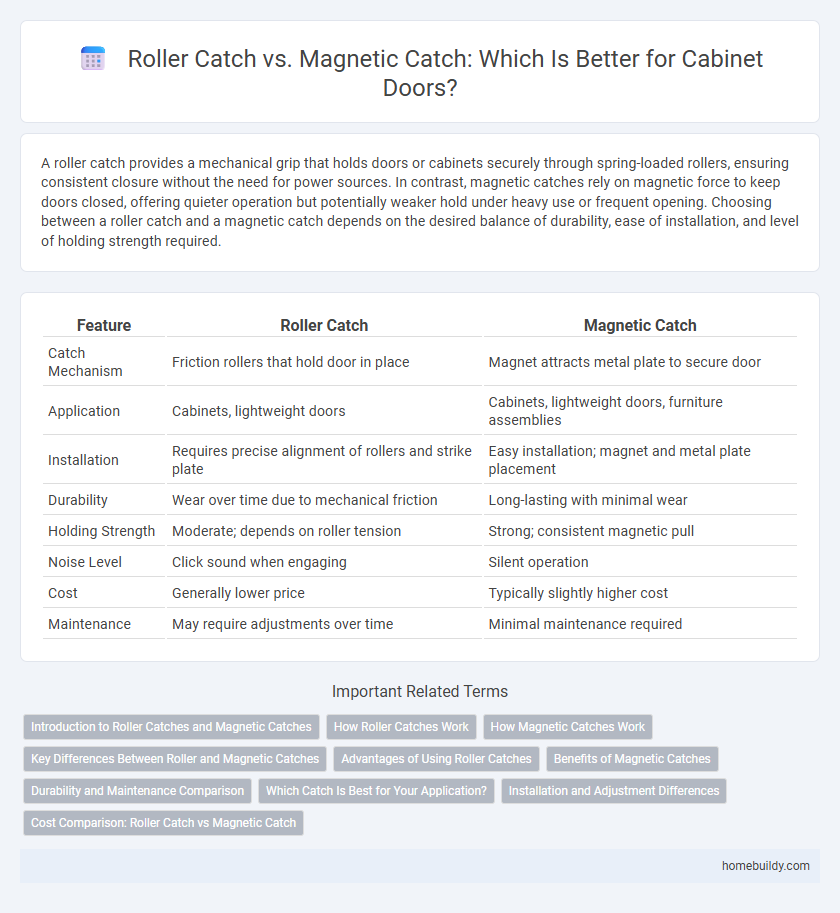A roller catch provides a mechanical grip that holds doors or cabinets securely through spring-loaded rollers, ensuring consistent closure without the need for power sources. In contrast, magnetic catches rely on magnetic force to keep doors closed, offering quieter operation but potentially weaker hold under heavy use or frequent opening. Choosing between a roller catch and a magnetic catch depends on the desired balance of durability, ease of installation, and level of holding strength required.
Table of Comparison
| Feature | Roller Catch | Magnetic Catch |
|---|---|---|
| Catch Mechanism | Friction rollers that hold door in place | Magnet attracts metal plate to secure door |
| Application | Cabinets, lightweight doors | Cabinets, lightweight doors, furniture assemblies |
| Installation | Requires precise alignment of rollers and strike plate | Easy installation; magnet and metal plate placement |
| Durability | Wear over time due to mechanical friction | Long-lasting with minimal wear |
| Holding Strength | Moderate; depends on roller tension | Strong; consistent magnetic pull |
| Noise Level | Click sound when engaging | Silent operation |
| Cost | Generally lower price | Typically slightly higher cost |
| Maintenance | May require adjustments over time | Minimal maintenance required |
Introduction to Roller Catches and Magnetic Catches
Roller catches provide secure yet easily releasable door retention through spring-loaded rollers that engage with a strike plate, offering smooth operation and durability. Magnetic catches use permanent magnets embedded in the catch body to hold doors closed, providing silent and reliable closure with minimal wear. Both roller catches and magnetic catches are popular choices for cabinetry and doors, with roller catches favored for adjustable tension and magnetic catches preferred for maintenance-free use.
How Roller Catches Work
Roller catches operate using a spring-loaded roller that compresses when a door is closed, allowing it to snap into a strike plate and hold the door securely in place. This mechanism provides smooth engagement and disengagement without requiring electrical components or magnets. Unlike magnetic catches, roller catches rely purely on mechanical tension for consistent closure and easy manual release.
How Magnetic Catches Work
Magnetic catches operate by using a magnet attached to one surface that attracts a metal plate or strike on the adjacent surface, creating a secure closure without mechanical parts. This magnetic force provides consistent holding strength and enables easy opening with a gentle pull, making it ideal for lightweight cabinet doors and furniture. Compared to roller catches, magnetic catches offer quieter operation and reduced wear, but may lack the stronger grip needed for heavier or more frequently used doors.
Key Differences Between Roller and Magnetic Catches
Roller catches rely on a spring-loaded roller mechanism to secure doors, offering smoother engagement and quieter operation compared to magnetic catches. Magnetic catches use magnets to hold doors closed, providing strong holding force but sometimes resulting in noisier latching and potential misalignment issues. The key differences include mechanical vs magnetic holding methods, noise levels during engagement, and suitability for various door types and weights.
Advantages of Using Roller Catches
Roller catches provide a secure hold with smooth, silent operation, making them ideal for frequently used doors and cabinets. Unlike magnetic catches, roller catches do not rely on magnets, ensuring consistent performance without interference from magnetic fields or metal objects. Their durable mechanical design offers enhanced longevity and reliable latching, especially in high-traffic environments.
Benefits of Magnetic Catches
Magnetic catches offer a quieter and smoother closing mechanism compared to roller catches, reducing wear on doors and frames. They provide consistent holding power without the mechanical components required by roller catches, increasing durability and reliability over time. Magnetic catches also accommodate slight misalignments better, ensuring secure closure even with imperfect door alignment.
Durability and Maintenance Comparison
Roller catches offer superior durability compared to magnetic catches due to their mechanical design, which withstands frequent use and heavy loads without losing functionality. Magnetic catches rely on magnets that can weaken over time, leading to decreased holding power and the need for replacement. Maintenance for roller catches is minimal, often requiring simple lubrication, whereas magnetic catches may demand periodic cleaning to prevent debris from diminishing magnetic strength.
Which Catch Is Best for Your Application?
Roller catches provide reliable mechanical latching ideal for doors requiring firm closure with moderate force, offering durability in heavy-use environments. Magnetic catches excel in applications needing silent, smooth operation and ease of release, making them perfect for lightweight cabinet doors or interior panel access. Selecting the best catch depends on factors like door weight, desired closure strength, noise tolerance, and frequency of use.
Installation and Adjustment Differences
Roller catches require precise alignment during installation to ensure the roller mechanism properly engages the strike plate, often necessitating fine adjustments for smooth door operation. Magnetic catches offer simpler installation with fewer adjustment needs, relying on magnetic force for holding power without mechanical engagement. The roller catch adjustment involves tuning spring tension or roller position, whereas magnetic catches typically require only proper placement of the magnet and metal plate for optimal function.
Cost Comparison: Roller Catch vs Magnetic Catch
Roller catches generally cost less than magnetic catches due to simpler materials and mechanisms, making them a budget-friendly option for securing cabinet doors. Magnetic catches require magnets and metal plates, which increases production costs and retail prices. In terms of long-term value, roller catches offer reliable performance with minimal maintenance expenses, while magnetic catches might incur higher replacement costs if magnets lose strength.
roller catch vs magnetic catch Infographic

 homebuildy.com
homebuildy.com